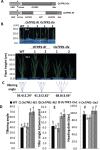Transcriptional corepressor OsTPR1 regulates tillering and lateral root development in rice
- PMID: 40691201
- PMCID: PMC12280221
- DOI: 10.1038/s41598-025-10224-6
Transcriptional corepressor OsTPR1 regulates tillering and lateral root development in rice
Abstract
TOPLESS (TPL) and TOPLESS-Related (TPR) corepressors are key regulatory proteins that interact with a variety of transcription factors to form specific complexes, thereby modulating a wide range of signaling pathways and metabolic processes. This study explored the function of the rice TPR gene OsTPR1. Transgenic rice lines overexpressing OsTPR1 (OsTPR1-Ox) exhibited reduced lateral root density, whereas OsTPR1 RNA interference lines (OsTPR1-Ri) showed increased lateral root density. To gain further insight, these transgenic lines were crossed with the DR5::GUS auxin reporter line. In 7-day-old seedlings, lateral root formation occurred in the differentiation zone of seminal roots, with GUS staining prominently localized in the lateral root primordia of the DR5::GUS/OsTPR1-Ri line. Similar results were observed in 45-day-old seedlings, where the DR5::GUS/OsTPR1-Ri line exhibited stronger GUS staining and a higher number of lateral roots in the crown root differentiation zones. In contrast, the DR5::GUS/OsTPR1-Ox line showed weaker GUS signals and fewer lateral roots. Additionally, the expression levels of several auxin efflux transporter genes encoding PIN-FORMED (PIN) proteins, including OsPIN1a, OsPIN1b, OsPIN1c, OsPIN2, and OsPIN5a, were increased in the OsTPR1-Ri line but decreased in the OsTPR1-Ox line. These results suggest that OsTPR1 also modulates the expression of multiple OsPIN genes, thereby potentially influencing auxin responses and lateral root development. Beyond root development, OsTPR1 overexpression led to a significant increase in tiller angle and a delay in flowering time, whereas OsTPR1-Ri plants exhibited earlier flowering. These findings indicate that OsTPR1 acts as a negative regulator of the auxin response, with its overexpression leading to reduced auxin sensitivity and altered plant architecture. Our results show that OsTPR1 modulates lateral root development, tiller angle, and flowering time, contributing to the coordinated growth and development in rice.
Keywords: Auxin; Heading date; Lateral root; Rice; TOPLESS-related protein (OsTPR1); Tiller angle.
© 2025. The Author(s).
Conflict of interest statement
Declarations. Conflict of interest: The authors declare no competing interests.
Figures





Similar articles
-
NIN-LIKE PROTEIN3.2 inhibits repressor Aux/IAA14 expression and enhances root biomass in maize seedlings under low nitrogen.Plant Cell. 2024 Oct 3;36(10):4388-4403. doi: 10.1093/plcell/koae184. Plant Cell. 2024. PMID: 38917216 Free PMC article.
-
OsPIN1b, OsPIN1c, and OsPIN9 mediate shoot-to-root auxin transport to activate cutting-induced compensatory root growth.Plant Physiol. 2025 Aug 29:kiaf385. doi: 10.1093/plphys/kiaf385. Online ahead of print. Plant Physiol. 2025. PMID: 40880072
-
The OsbHLH166-OsABCB4 module regulates grain length and weight via altering auxin efflux.Sci Bull (Beijing). 2025 Jul 15;70(13):2125-2136. doi: 10.1016/j.scib.2025.04.053. Epub 2025 Apr 28. Sci Bull (Beijing). 2025. PMID: 40374475
-
To grow or not to grow: the enigma of plant root growth dynamism.Plant Mol Biol. 2025 Jul 30;115(4):93. doi: 10.1007/s11103-025-01631-4. Plant Mol Biol. 2025. PMID: 40736880 Review.
-
Auxin Signaling Mediated Spatial Accommodation Mechanisms During Lateral Root Development.Physiol Plant. 2025 Sep-Oct;177(5):e70481. doi: 10.1111/ppl.70481. Physiol Plant. 2025. PMID: 40898386 Free PMC article. Review.
References
-
- Brand, U. et al. Dependence of stem cell fate in Arabidopsis on a feedback loop regulated by CLV3 activity. Science289, 617–619. 10.1126/science.289.5479.617 (2000). - PubMed
-
- Schoof, H. et al. The stem cell population of Arabidopsis shoot meristems is maintained by a regulatory loop between the CLAVATA and WUSCHEL genes. Cell100, 635–644. 10.1016/S0092-8674(00)80700-X (2000). - PubMed
MeSH terms
Substances
LinkOut - more resources
Full Text Sources

